
The world over, food is at the center of life. Whether we cook at home for loved ones or go out to eat, food is our fuel.
As such, it comes as no surprise that it should be so central to our language. When studying a new language, it’s absolutely essential to learn things like how to order at a restaurant, how to ask for seconds, and what to call different types of foods and ingredients so you can find them at the store or market. Having a knowledge of Israeli and Jewish food can open so many doors for the aspiring Hebrew learner.
In particular, the Jewish and Israeli food culture reflect several important aspects of the people as a whole.
Firstly, Judaism takes great interest in food. Some examples of this include…
- …prohibiting some foods outright (such as pork and shellfish).
- …prohibiting others only when in combination with one another (such as dairy and meat products).
- …using food as a vehicle for religious and cultural ceremonies.
- …abstaining from food on fast days.
Aside from this, there’s an entire set of blessings for different foods and beverages, both before and after consuming them, as well as various other rituals that revolve around food. In fact, Judaism uses food as the bridge between the spiritual and the physical. It does this by imbuing foods with spiritual significance, and then putting those ideas or energies into the body through the mouth.
Apart from the religious side of things, Jews lived in almost all corners of the Earth during the two-millenia Diaspora, before returning to the Land of Israel in the latter half of the nineteenth century. When they returned, they brought with them a veritable kaleidoscope of culinary traditions. As such, so-called Israeli food is really a fusion of indigenous fare and cooking styles from all around the globe, making the final result all the more interesting to taste and experience.
Moreover, Israel, from Biblical times until today, has been prized for the fertility of its soil. Combined with Israel’s world-renowned agricultural prowess, the grains and produce it grows—which form the basis of many dishes common to the Israeli table—are as colorful as they are delicious.
Perhaps the best part of it all is that focusing on the language of food is a great way to have fun while learning. Not only will you make new friends around the table, but you’ll also experience some of the best of Israeli culture in both its cuisine and its eating culture. Speaking of, don’t expect much table etiquette in Israel. But don’t worry. The phenomenal dishes, great conversation, constant and emphatic sharing, and general warmth and fun of the atmosphere are bound to bring a smile to your face.
 Table of Contents
Table of Contents
- Must-Try Dishes in Israeli Restaurants
- Important Foods in Judaism
- Foods You Can Only Get in Israel (Or That are Only Worth it Here)
- Essential Vocabulary for Food and Drinks
- Bonus: Simple Recipes to Make Authentic Israeli Food at Home
- Have Fun Learning with HebrewPod101
1. Must-Try Dishes in Israeli Restaurants
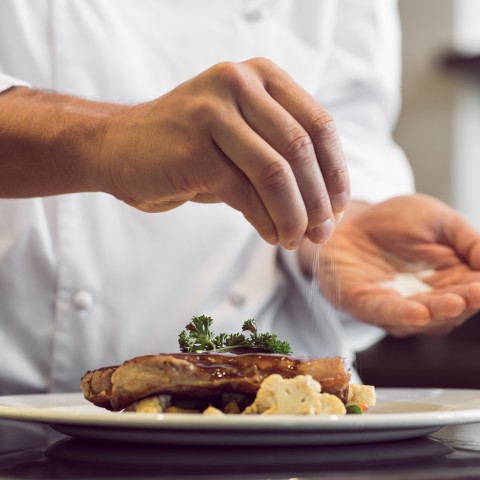
As the title says, בתאבון (be-te’avon) means “Bon appetit” in Hebrew. This is something you can expect to hear anytime food’s involved, whether from a waiter in a fancy restaurant or from a stranger as you eat a sandwich on a park bench in Tel Aviv!
Israelis love food—making it, eating it, and serving it!
So let’s start by having a look at perhaps the most iconic Israeli foods, though this is definitely a tough shortlist to make. Israeli cuisine represents seemingly endless culinary traditions, from Russian to Morrocan, Greek to Hungarian, Iraqi to Polish. However, the dishes we’ll look at below could be considered the most typical Israeli food items, regardless of their particular cultural extraction.
1. חומוס
Khummus
“Hummus”
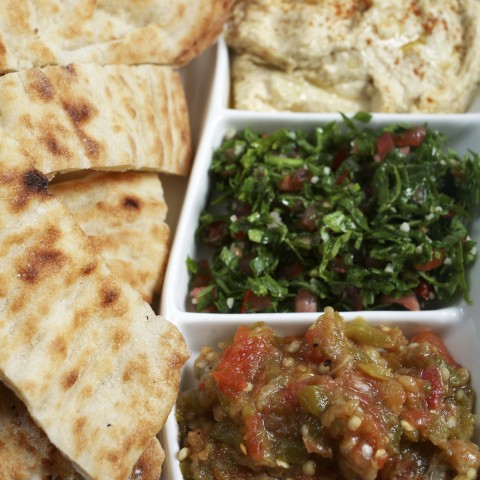
This one is definitely a contentious first entry, in light of the fact that hummus is claimed to have originated in numerous countries. The only thing that seems certain is that it’s indigenous to the Levant (that and the fact that we all love it, whether we’re Egyptian, Syrian, Lebanese, or Israeli)!
In both Hebrew and Arabic, the word ‘hummus’ refers both to the garbanzo bean (or chickpea), and to the creamy, flavorful prepared dip made from it. In Israel, where hummus is the go-to spread and dip by itself or mixed with all sorts of other foods, there are numerous variations of the preparation. But to keep things simple, here’s what your basic hummus would contain.
Ingredients
- גרגרי חומוס מבושלים
gargerey khumus mevushalim
“cooked garbanzos” (sometimes cooked with spices and/or root vegetables in the water to add flavor)
- טחינה
t’khinah
“Tahini paste” (made from milled sesame seeds)
- שום
shum
“garlic”
- מיץ לימון
miytz limon
“lemon juice”
- מלח
melakh
“salt”
- פלפל שחור
pilpel shakhor
“black pepper”
- תבלינים
tavlinim
“spices” (these generally include cumin, but the possibilities are endless and depend on the chef)
Preparation
These ingredients are mashed into a fine paste, which is typically served in a deep bowl, a ring spooned into it so olive oil can be drizzled into the rut. The oil is often sprinkled with fresh parsley, paprika, and sometimes zaatar (a spice mix with hyssop and sesame seeds). The hummus can be topped with anything: sautéed mushrooms, roasted pine nuts, ground meat, and the list goes on.
2. פלאפל
Falafel
“Falafel”
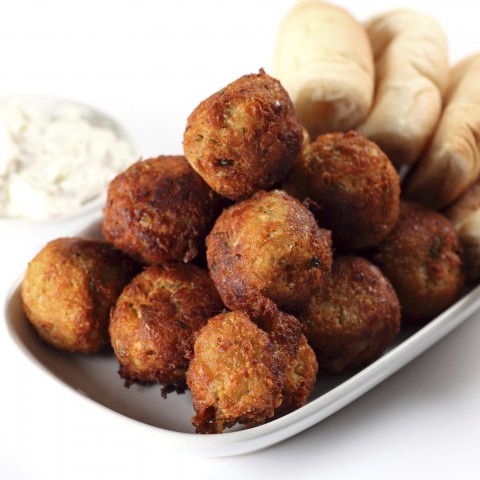
This classic and ubiquitous Middle Eastern dish, also made from garbanzos, is also claimed to have originated in multiple parts of the region. But even if Israelis didn’t invent it, it can definitely be argued that the country elevated it to an art form. In fact, a common topic for debate among Israelis is where you can find the best falafel in the country. Below is how it’s typically prepared.
Ingredients
- גרגרי חומוס מושרים במים
gargerey khumus musharim be-mayim
“soaked garbanzos”
- פטרוזיליה
petroziliyah
“parsley”
- כוסברה
kusbarah
“cilantro”
- בצל
batzal
“onion”
- סודה לשתייה
sodah le-shtiyah
“baking soda”
- מלח
melakh
“salt”
- פלפל שחור
pilpel shakhor
“black pepper”
- תבלינים
tavlinim
“spices” (these generally include cumin and paprika, but the possibilities are endless and depend on the chef)
Preparation
These ingredients are chopped and/or ground up finely and formed into a paste, which is then shaped into balls. The balls are deep-fried and usually served in pita bread (see below), along with your choice of salads and sauces (typically tahini at minimum), and sometimes french fries as well.
3. פיתה
Pitah
“Pita Bread”
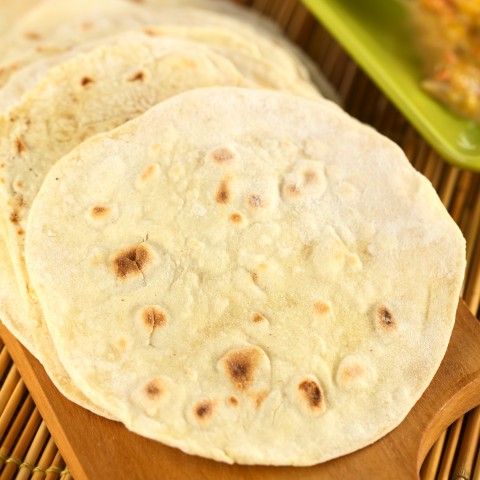
This popular food in Israel is the standard bread used to serve falafel (see above) or shawarma (see below), for dipping hummus (see above), and for making sandwiches.
Ingredients
- קמח חיטה
kemakh khitah
“wheat flour”
- מים
mayim
“water”
- שמרים
sh’marim
“yeast”
- סוכר
sukar
“sugar”
- מלח
melakh
“salt”
Preparation
The key to what makes pita bread so special is its pocket, where the contents of your sandwich go. This is achieved by rolling the dough out to just the right thickness and then baking it at a very high temperature, which steams the moisture within the dough. This steam pushes on and stretches from the dough, and when the baking is done, the pita bread has separated into two layers with a beautiful pocket in the middle. Pita bread is characterized by its elastic crust and chewy crumb.
4. שקשוקה
Shakshukah
“Shakshuka”

This is a classic Israeli breakfast. But keep in mind that eggs are not eaten exclusively at breakfast in Israel, so you may even find it on a restaurant’s lunch menu.
Ingredients
- ביצים
beytzim
“eggs”
- עגבניות
agvaniyot
“tomatoes”
- גמבה
gambah
“bell pepper”
- בצל
batzal
“onion”
- שום
shum
“garlic”
- רסק עגבניות
resek ‘agvaniyot
“tomato paste”
- פטרוזיליה
petroziliyah
“parsley”
- כוסברה
kusbarah
“cilantro”
- תבלינים
tavlinim
“spices” (these generally include cumin, paprika, and chili powder)
Preparation
The onion, garlic, and bell pepper are sautéed to perfection; the tomato paste and tomatoes are added on top; and finally, the eggs are cracked right into wells made into the mixture. The pan is covered and the eggs are cooked right into the mixture to the desired doneness. This dish is usually served garnished with chopped parsley and cilantro.
5. שווארמה
Shawarmah
Shawarma
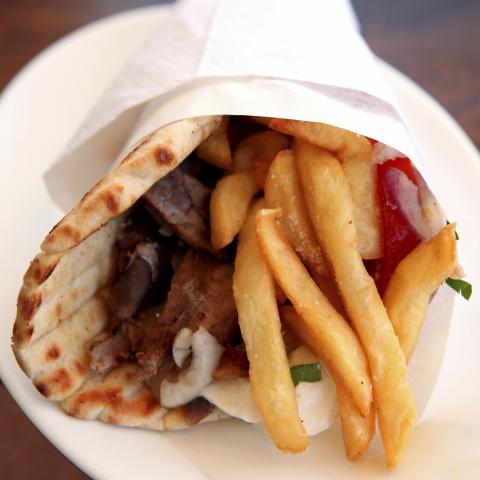
Last but not least, this is the carnivore’s choice when visiting Israel. This dish is well-known throughout the Middle East, and is also popular wherever Middle Eastern immigrants to other countries have set up their carts and shops.
Known as doner kebab in its Turkish (and original) form, this is a vertical stack of layered meat that turns and slow-roasts rotisserie style on a spit throughout the course of the day. The meat, which can be lamb, chicken, beef, or turkey (the latter of which is the most common in Israel) is seasoned before roasting, and a layer of fat and an onion are placed on top, with the onion-infused fat dripping down into the meat as it cooks.
Ingredients
- בשר
basar
“meat”
- בצל
batzal
“onion”
- שומן
shuman
“fat”
- תבלינים
tavlinim
“spices” (these vary but can include cumin, cardamom, cinnamon, turmeric, and paprika)
Preparation
The meat is sliced from the spit with either a sharp knife or something resembling a barber’s electric clippers, then quick-fried on a griddle, usually with onions, and served in either pita bread or lafa (a thicker flat bread that’s used as a burrito-like wrap). The shawarma generally gets served with the same sorts of sides and sauces that are offered with falafel.
2. Important Foods in Judaism
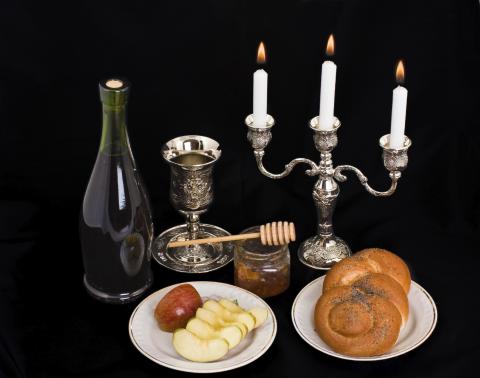
As mentioned in the introduction, Judaism and food are closely tied together. Judaism in general is a very symbolistic culture, but food takes pride of place when it comes to symbolism. There are even cases of this in the Bible itself, such as the fruit of the Tree of Knowledge in the story of Genesis representing the forbidden fruit. As the majority of Israel’s inhabitants are Jewish, Jewish holidays are the most celebrated ones, and many of these involve authentic Jewish cuisine. Let’s have a look at the most important foods.
1. חלה
Khallah
“Challah Bread”
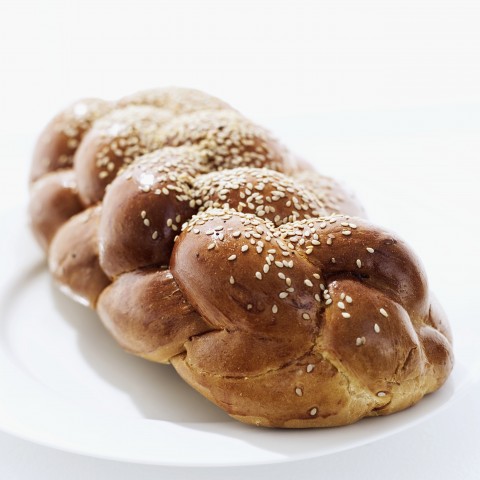
This is the bread that’s traditionally baked for שבת (Shabbat) or the “Sabbath,” the Jewish day of rest which begins sundown every Friday and ends Saturday night. The bread represents the fact that this is a day of rest for God as well as man. One of the ways in which God rested was in not raining down Manna for the Israelites to eat when they wandered for forty years in the Sinai Desert on their way from Egypt to the Land of Israel. Instead, God, the Bible tells us, rained down a double portion on Friday which was to last for both Friday and Saturday.
There is further symbolism baked into this bread. Apart from the fact that we traditionally serve two loaves of Challah on the Sabbath, the bread is usually braided out of three strands, which create six parts per loaf. Two loaves of six parts make twelve, which represent the 12 Tribes of Israel.
2. מצה
Matzah
“Matza”
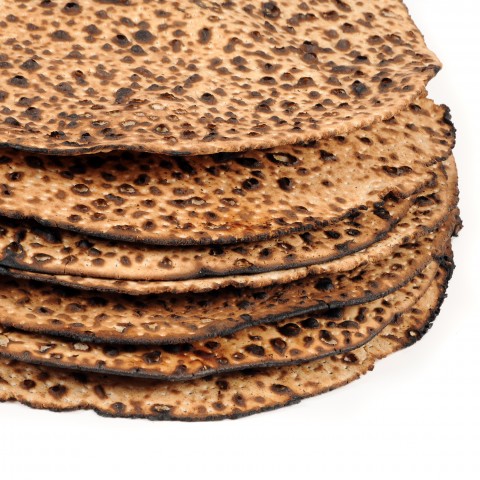
This is another bread, and one that also has its roots in the Exodus story. According to the Bible, when the enslaved Israelites were finally let free by the Pharaoh after the last of the 10 Plagues (in which the Pharaoh’s son was slain), they left in such haste that they had no time to wait for their bread to rise. Therefore, they took along simple, unleavened bread—essentially, big plain crackers.
Matza is made from only wheat flour and water. No yeast, no salt, no sugar. What’s more, it’s made in just eighteen minutes from start to finish (eighteen minutes being the numerical equivalent to חי [khay], the Hebrew word for “life”). Jews around the world, including Israel, eat this plain bread during the eight days of פסח (Pesakh), or Passover, the observant ones eating it exclusively while they abstain from any leavened bread or flour products.
3. לביבות
Levivot
“Latkes”
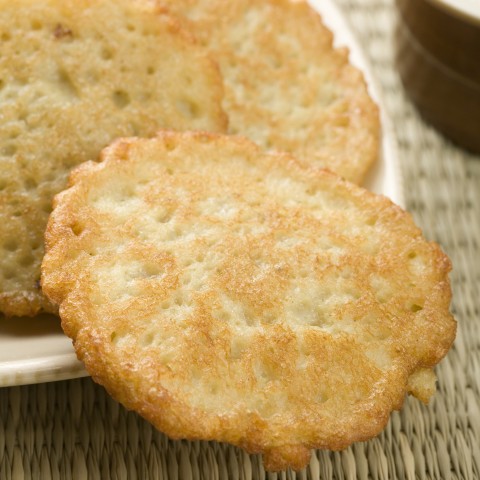
This traditional Jewish food is eaten to celebrate חנוכה (Khanukah), or “Hanukkah,” when we commemorate the victory of the Jewish Maccabees against the Greek Empire. According to the legend, when the Maccabees were able to recapture the Holy Temple in Jerusalem, they discovered that the מנורה (menorah), or “candelabrum,” that was always lit in the Temple to God’s eternal glory had been extinguished and defiled by the Greeks. What’s more, the Maccabees could only find one little jug of olive oil with which to light the candelabrum. But the oil miraculously kept for eight days, hence the eight days of Hanukkah’s celebration.

And what better way to celebrate—aside, of course, from lighting our own little candelabra—than to eat fried food, in memory of that magical oil? Latkes in Yiddish, or levivot in Hebrew, are fried potato pancakes, traditionally served with applesauce and sour cream. Yum!
4. אוזני המן
Ozney Haman
“Hamentashen”
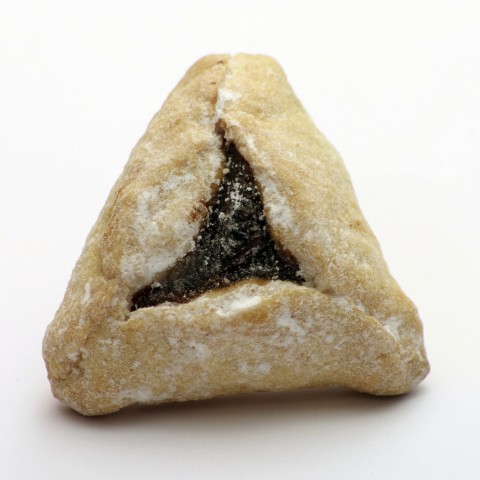
These little treats are eaten on פורים (Purim), or “Purim,” which celebrates the Jews’ victory against impending doom at the hands of the villain Haman. Purim is a day of feasting and partying, including dress-up parties much like Halloween, and Hamentashen are one of the traditional sweets associated with the holiday. In memory of Haman’s tri-cornered hat, these are triangular cookies filled with jam (usually apricot, plum, or raspberry).
5. בלינצ’ס
Blinches
“Blintz”
The blintz is yet another holiday food, this one for the holiday of שבועות (Shavu’ot), or “Pentecost.” This holiday celebrates the Israelites’ reception of the תורה (Torah), or “Hebrew Bible,” after being liberated from Egypt. According to Jewish tradition, as the Jews did not yet know the laws pertaining to kosher foods, they abstained from eating meat until the Bible was given to them. In commemoration, Jews eat a lot of dairy dishes on this holiday, with blintzes being the most iconic.
These are similar to a crepe, though with a thicker, usually crunchier shell. They’re filled with cheese, usually cottage or farmer’s cheese, and may also have some fruit added either inside or as a topping.
3. Foods You Can Only Get in Israel (Or That are Only Worth it Here)
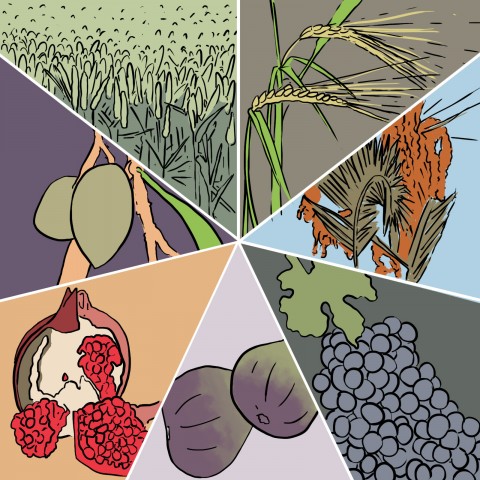
We’ve looked at some of Israel’s most popular dishes, as well as some of the more traditional Jewish foods. In both cases, these foods have traveled far and wide, bearing signs of foreign cuisines. Now let’s look at five foods that are either unique to Israel or better here than anywhere else.
1. במבה
Bamba
“Bamba”
This is the iconic Israeli snack (some might call it junk food), making up twenty-five percent of the entire snack market. Although there’s nothing particularly Israeli about corn or peanuts, both originally from Mexico, Bamba is an entirely Israeli invention using these two ingredients. Essentially, a peanut butter-flavored puffed corn snack, Bamba is apparently also responsible for the low incidence of peanut allergies in Israel, as most kids eat it from an early age!
2. ביסלי
Bisli
“Bissli”
This snack is the runner-up to Bamba, with over 4,000 tons of it produced each year in Israel. This one, probably even less healthy than Bamba, is essentially fried pasta that has a very crunchy mouthfeel. It comes in different pasta-like shapes as well as various flavors, including grill, barbecue, pizza, falafel, onion, and even taco. The name, it should be noted, translates roughly to “a bite for me.”
3. קרמבו
Krembo
“Krembo”
Moving deeper into the category of guilty pleasures, let’s look at another one of the most popular Israeli food products. This is a uniquely Israeli sweet. Its name means “cream in it,” and that’s just what it is. Krembo has a biscuit base topped with a whipped, marshmallow-like filling, all coated with chocolate. Because of Israel’s sultry climate, these fragile treats, prone to melting, are only sold from October to February, making their appeal that much greater to the sweet-toothed.
4. סביח
Sabikh
“Sabich”
More of a substantial item, sabich, though an original Israeli creation first whipped up in Tel Aviv, is based on a traditional Sabbath breakfast typical of Iraqi Jews. It’s a pita bread sandwich stuffed with sliced hard boiled eggs, fried eggplant (which is sometimes breaded), and Israeli salad (see recipe below), drizzled with Tahini sauce, עמבה (‘ambah) or “amba”—a sort of pickled mango chutney—and often hot sauce, as well. The hard boiled eggs and eggplant (along with boiled potatoes) were traditional Iraqi Jewish foods for Sabbath morning as no cooking is allowed on the Sabbath; these could be prepared ahead of time and eaten cold.
5. נקטר
Nektar
“Nectar”
Last but not least, we strongly recommend trying some of the so-called fruit nectars produced in Israel. Essentially, these are thickly textured fruit juices, but the unique flavors—including pear, mango, cherry, peach, and orange—and the quality of the Israeli fruits used to make them, make these a winner. There are two main brands for these types of nectars in Israel: פרימור (Primor) and פריגת (Prigat).
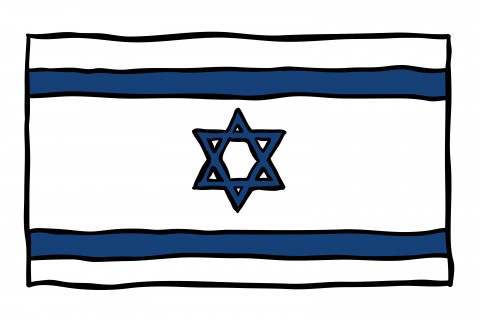
4. Essential Vocabulary for Food and Drinks
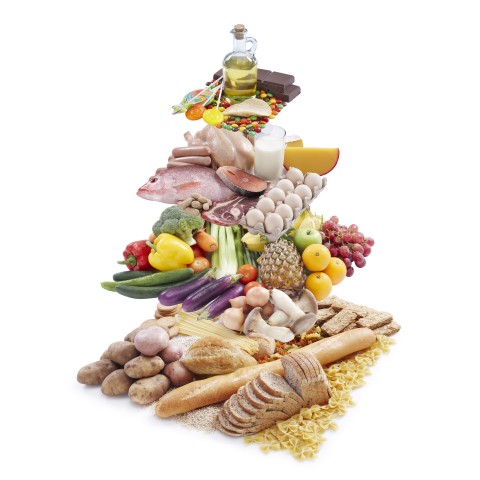
To accompany our look at the top Israeli and Jewish foods, here’s a list of key vocabulary words for food, including cooking food and ordering food at a restaurant.
A- General Eating/Drinking Words
- לאכול
le’ekhol
“to eat”
- לטעום
lit’om
“to taste”
- לשתות
lishtot
“to drink”
- לקחת שלוק
lakahat shluk
“to take a sip”
- לקחת ביס
lakakhat bis
“to take a bite”
B- Cooking Words
- לבשל
levashel
“to cook”
- לטגן
letagen
“to fry”
- לצלות
litzlot
“to roast”
- להרתיח
leharti’akh
“to boil”
- לתבל
letabel
“to season”
- להמליח
lehamli’akh
“to salt”
C- Restaurant Vocab
- תפריט
tafrit
“menu”
- מלצר/ית
meltsar/it
“waiter” / “waitress”
- להזמין
lehazmin
“to order”
- חשבון
kheshbon
“check” / “bill”
- מנה ראשונה
manah rishonah
“appetizer”
- מנה עיקרית
manah ‘ikarit
“entrée” / “main course”
- קינוח
kinu’akh
“dessert”
D- Drink Names
- מים
mayim
“water”
- יין
yayin
“wine”
- בירה
birah
“beer”
- קולה
kolah
“cola”
- לימונדה
limonadah
“lemonade”
- מיץ
mitz
“juice”
- חלב
khalav
“milk”
- קפה
kafeh
“coffee”
- תה
teh
“tea”
5. Bonus: Simple Recipes to Make Authentic Israeli Food at Home
As a bonus, here are some quick and easy recipes you can use to make authentic Israeli dishes at home. If you can, find a native Israeli to help taste your dish when it’s ready so they can criticize it! (Just kidding!) They will, however, most likely comment on what, if anything, is missing or needs to be added (more salt, less oil, etc.), thereby helping you achieve that authentic touch.
1. Easy Hummus

Ingredients
- 500 grams (about 17.5 ounces) of garbanzo beans, soaked 8-10 hours with a bit of salt (preferably change the water halfway through)
- 1 tbsp vegetable stock
- 3-5 bay leaves
- 300 ml raw Tahini paste
- 2-3 cloves garlic, minced
- 2-3 tsp salt
- ½ tsp black pepper
- ¼-½ tsp cumin
- juice from 2-4 lemons
- roughly 200-300 ml water
- olive oil
- paprika
- zaatar
- 1 small bunch fresh parsley
Steps
1. Boil the garbanzo beans in water so they are covered an inch or so, mixing the stock and bay leaves into the water. Preferably use a pressure cooker on high pressure (eight minutes once pressure is reached, then quick release the pressure). Otherwise, cook until the garbanzos squish easily between the fingers (30-50 minutes).
2. Strain and cool the garbanzos, removing the bay leaves.
3. Use a food processor or mash by hand with the Tahini, minced garlic, salt, pepper, cumin, and lemon juice, depending on how strong you want the lemon flavor to be.
4. Finally, add water little by little to achieve the desired creaminess.
5. Serve in a bowl, forming a ring with a spoon and drizzling olive oil in the rut, then sprinkling with paprika, zaatar, and fresh parsley. You can use other spices if you prefer.
2. Quick Shakshuka
Ingredients
- 1 medium onion, diced
- 1 red bell pepper, seeded and diced
- 3-4 garlic cloves, diced
- 2 tsp paprika, preferably smoked
- 1 tsp cumin
- 1/4 tsp chili powder (optional)
- 1 can tomato paste or whole peeled tomatoes
- 6 large eggs
- salt and pepper, to taste
- 1 bunch fresh cilantro, chopped
- 1 bunch fresh parsley, chopped
- olive oil
Steps
1. Heat olive oil in a large, deep pan on medium heat. Add the pepper and onion and cook for about five minutes, until the onion becomes translucent.
2. Add the garlic and dry spices and cook for an additional minute.
3. Pour the tomato sauce or peeled tomatoes in, along with all the juice. If using peeled tomatoes, mash them up using a large spoon. Season with salt and pepper and bring the sauce down to a simmer.
4. Use a large spoon to make six small wells in the sauce, then crack the eggs right into the wells. Cover the pan and cook for 5-8 minutes, or until the eggs are done to your liking.
5. Garnish with cilantro and parsley, adding salt and pepper if desired.
3. Israeli Salad
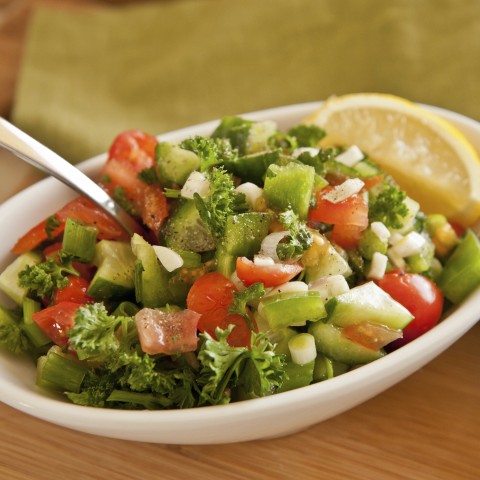
Ingredients
- 1 lb Persian cucumbers, finely diced
- 1 lb fresh ripe tomatoes, finely diced
- 1/3 cup minced onion (optional)
- 1/2 cup fresh parsley, chopped
- 3 tbsp olive oil
- 3 tbsp fresh lemon juice
- Salt and pepper to taste
Steps
1. Chop the vegetables as finely as you wish. Traditional Israeli salad is very finely diced.
2. Mix the vegetables with the parsley and onion if using, and drizzle with oil and lemon juice.
3. Add salt and pepper to taste.
6. Have Fun Learning with HebrewPod101
We hope you’ve enjoyed our lesson on traditional Israeli and Jewish food. Our aim at HebrewPod101.com is to make learning a fun but practical experience. If you can navigate your way around an Israeli table, you will have proven yourself a Hebrew pro—not just in the linguistic sense, but also in the cultural one!
Be sure to check out our other lessons on Hebrew culture, including Hebrew music, Hebrew TV shows and movies, and Hebrew YouTube channels. Is there another aspect of Hebrew culture that interests you? Feel free to let us know, as we are here to serve you!
Now go serve yourself some Israeli food, and we wish you בתאבון (be-te’avon), “Bon appetit!”










